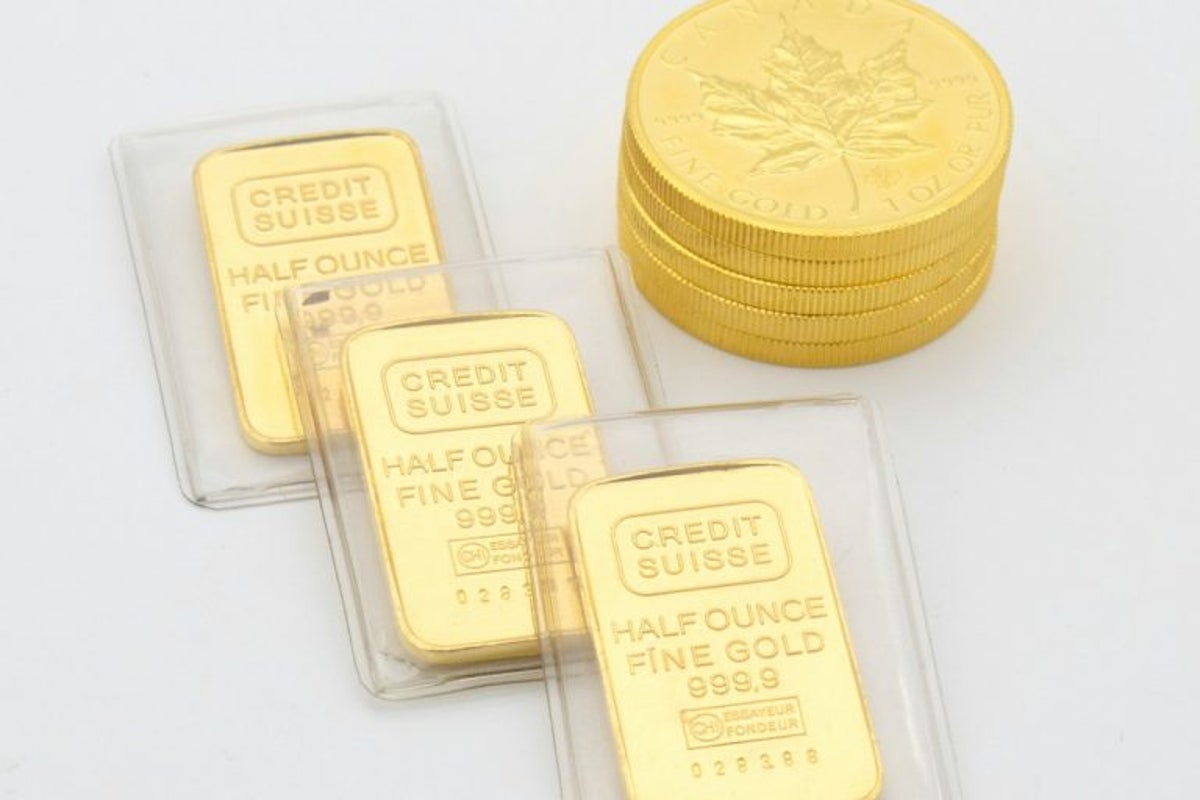Invest in gold through a gold IRA with American Hartford Gold or Advantage Gold and start growing your investments today.
Of all the elements on the periodic table, none possess more mystique and allure than gold. It’s the metal that has set off international conflicts and mad dashes for instant wealth.
Gold is one of the most coveted alternative investments and has been for decades. Investors like gold as a bedrock commodity that can retain its value in challenging economic times. Gold isn’t sold on the stock exchange, leaving many common investors wondering how to buy in.
Benzinga takes a closer look at how to invest in gold and where to find it.
5 Ways to Invest in Gold
Some forms of gold investments have been around for thousands of years. Others are more tailored for 21st-century investors. Here are five options for buying gold.
Buying Physical Gold
Items made from gold are tangible assets, unlike most other investment commodities. They can be safe havens in times of economic chaos, serving as hedges against losses. Gold’s relative illiquidity makes it a fit for a diversified portfolio.
Before jumping in, an investor needs a reputable dealer who emphasizes transaction transparency and security and puts their customers first. A shady dealer, however, might keep their business practices under lock and key. Many are high-pressure salespeople who offer few options for investments and dance on the edge of legality.
When shopping for physical gold at professional dealerships, look for those who:
- Keep transactional fees to a minimum
- Provide 24-hour storage or know of options for this
- Offer a variety of gold-based items and products
- Provide information and education on gold markets
- Welcome questions and feedback
Here are some of the most popular and promising options for obtaining physical gold.
Gold Bullion
Gold bullion is the purest of the precious metals, with purity rates of 99.5% to 99.9%. Bullion is made from gold ore, a mix of gold and mineralized rock. The gold is extracted from the rock at high temperature to produce pure gold bullion. It’s then fashioned into bars, ingots and rounds.
Gold bullion has an unusual value prop. All of its value is tied to intrinsic worth — its gold content. Gold has had high value for centuries. Pure gold’s worth is all about the purity of the gold content and its long-standing status as a precious metal.
Bullion is sold in troy ounces, which is standard for precious metals. Troy ounces were invented centuries ago to create this standard. The adoption of the troy ounce for gold made for price consistency among worldwide traders of precious metals.
Gold Coins
Historic gold coins of certain eras, mintages and countries attract collectors willing to pay more for rare items. This feature gives coins an edge over other gold bullion options in which value derives from weight and purity.
In gold markets, coins are identified with eras and events in the history of the world. The scarcer the coin is, the better the chance of a strong return. Some of the most valuable gold coins in the world include:
- 1933 Double Eagle
- 1822 Capped Bust Half Eagle
- 1870-S Indian Princess Head Gold Coin
- 1854-S Coronet Head Gold Half Eagle
- 1804 Turban Head Gold Eagle “Plain 4”
The benefits of collecting gold coins include their tangibility, multiple configurations, historical import and portability.
However, gold coins can come with overpriced premiums, especially compared to gold bullion. Finding secure storage for the coins can be a strain. Since they’re relatively illiquid, selling gold coins can take longer and are subject to trends in the collectibles markets.
Gold Jewelry
Collectors emphasize the condition, design and craftsmanship that goes into gold jewelry. Extreme precision is necessary in making jewelry. It’s easy to find buyers, though it’s not always easy to close the deal. Having collectors and investors both going after jewelry increases its customer pool.
Gold jewelry must be hallmarked — that is, stamped somewhere with identifying information (karat size, weight, origin). Hallmarked jewelry offers official assurance about the purity, authenticity and quality of the gold. Potential customers will be more willing to pay extra for an authentic, certified gold jewelry piece.
Gold jewelry needs to be carefully maintained. Keeping the jewelry in pristine condition maintains its worth over the years, increasing its reselling value and its marketability.
It’s important to line up extremely safe storage options for jewelry, whether in a bank safe deposit box, a private vault facility or a heavily fortified personal vault. You might need to purchase insurance for the item.
Buying Gold Futures and Options
Gold futures and options work in much the same way as stock futures and options. They carry the same level of risk and potential for reward.
When you buy a gold future, you’re agreeing to a contract to buy an amount of gold at a set price in the future. Let’s say gold is currently selling on the marketplace for $1,500. But you are certain that the price will be $2,500 in a few weeks or months. You don’t want to wait until it does because it won’t be profitable for you.
In this case, you can buy a gold future, committing to pay $1,500 for the gold two or three months from now. You sit back and hope for the price of gold to inch up for a few weeks. By the time of the buy date on your contract, it has reached $2,500 a unit.
When the contract date arrives, you purchase the gold at your original, agreed-upon premium of $1,500. Just like that, you’ve made $1,000 (before cashing out) because you can re-sell the gold at current prices and turn a hefty profit.
Gold options work the same way — except you’re not obligated to buy the gold at the agreed-upon time. You just have the option to do so. In the last example, you can buy an option to buy the gold at $1,000 two or three months from now.
When the date comes, gold has slipped a little to $900. You can, therefore, decide not to buy the gold and let the option lapse. All you’ve lost are the fees you spent to buy the option.
Success in the futures and options markets hinges on strategy. Traders closely follow market trends since they suggest future patterns. Some try spread trading, in which they buy futures and options at the same time to hedge against the overall market. There are several clever ways to maximize options, including put and call options and calendar spreads.
However, the futures and options market is fraught with risk. Investors must stay on top of the deadlines for multiple options. Premium prices make it hard to turn a profit.
Investing in Gold ETFs and Mutual Funds
Access to gold commodities is broadened by dedicated exchange-traded funds (ETFs) and mutual funds, two popular ways to invest in multiple commodities at once.
Exchange-Traded Funds
ETFs can provide instant portfolio diversity by offering multiple commodities centered around themes — industries, sectors, market caps, stock indexes and so forth.
A few ETFs focus on gold, including:
- SPDR Gold Trust (NYSEARCA: GLD)
- iShares Gold Trust (NYSEARCA: IAU)
- SPDR Gold MiniShares Trust (NYSEARCA: GLDM)
- VanEck Gold Miners ETF (NYSEARCA: GDX)
- abrdn Physical Gold Shares ETF (NYSEARCA: SGOL)
- GraniteShares Gold Trust (NYSEARCA: BAR)
You can trade ETFs on the stock exchange anytime the market is open.
Another benefit is that ETFs offer some access to alternative investments that you can’t buy straight from the stock market. You can’t get gold shares at the NYSE, but you can purchase shares in an ETF with multiple gold positions.
One of the measurements of cost in holding a gold ETF is the fund’s expense ratio. This calculation addresses the administrative costs of running the ETF and usually comprises the shareholders’ annual fees. The lower the ratio, the less investors’ funds go to managing the ETF.
Right now, the average expense ratio for gold ETFs is between 0.20% and 0.50% — a moderate range.
Mutual Funds
Mutual funds are the forerunners of ETFs. Some of the more popular gold mutual funds include:
- First Eagle Gold Fund Class A (MUTF: SGGDX)
- Invesco Gold & Special Minerals Fd Class A (MUTF: OPGSX)
- Franklin Gold and Precious Metals Fund Class A (MUTF: FKRCX)
- VanEck International Investors Gold Fund Class A (MUTF: INIVX)
- American Century Global Gold Fund A Class (MUTF: ACGGX)
- OCM Gold Fund Investor Class (MUTF: OCMGX)
Mutual funds are overseen by fund managers a little more closely than ETFs are supervised. Some require minimum investments. They’re only tradable at the end of the business day, which is convenient for some investors and irritating to others.
However, mutual funds have higher expense ratios and lower liquidity than ETFs.
Buying Gold Mining Stocks
The stock exchange doesn’t cover gold as a commodity – but it does cover the companies that retrieve the gold from the mines. Shares in gold mining stocks are available from most exchanges. Some of the most well-known include:
- Barrick Gold Corp. (NYSE: GOLD)
- Newmont Corp. (NYSE: NEM)
- Franco-Nevada Corp. (NYSE: FNV)
- Wheaton Precious Metals Corp. (NYSE: WPM)
- AngloGold Ashanti PLC (NYSE: AU)
Buying shares in gold stocks is straightforward if you already have a brokerage account. If you don’t, most of them are free to sign up. You’d access your account, add funds, search for and research different stocks and place an order to buy at the next available moment via a market or limit order.
Investing in Gold IRAs
Individual retirement accounts (IRAs) are how Americans have prepared for retirement for almost 50 years. Gold IRAs are unique retirement vehicles that specifically allow for holdings in gold and other precious metals like silver, platinum and palladium.
Commodities a gold IRA might manage include physical gold, mutual funds, ETFs and mining stocks.
Gold-centric IRAs offer similar tax advantages that steer people toward traditional IRAs. The biggest advantage of gold IRAs is that they permit investors to put physical gold among their holdings. Roth and traditional IRAs tend to avoid alternative investments altogether.
Should You Invest in Gold?
How should you approach gold investing compared to other types of investments? First, it’s always a good idea to form a list of financial goals to work off. Then, analyze your risk tolerance. These are standard first steps for any investor.
As far as gold-related investments are concerned, there are a few specific benefits — and potential traps — to consider.
Pros and Cons of Gold Investing
Key advantages include:
- Portfolio diversification
- Hedging against inflation
- More liquidity, especially with ETFs
- Tangible investments, if buying physical gold
- High global demand
Some of the potential drawbacks include:
- No or little chance to earn passive income
- History of trailing stocks in the long-term
- Costs of storage and security
Weigh these pros and cons against your objectives to decide whether gold investing is right for you.
Going for the Gold
Gold possesses an indelible aura and prestige that it’s likely to retain. With the right moves, it can become one of your most valuable assets.
Frequently Asked Questions
A
It could be. Investors like to buy gold because of its long-term stability, particularly as a hedge against inflation, market swings and currency devaluation (including the U.S. dollar).
A
Gold bars may be more practical with high purity and lower premiums. Coins may hold aesthetic appeal for collectors and often have value beyond the gold content.
A
Some banks buy gold to stave off inflation and promote stability. Most don’t sell gold because of price fluctuation. Therefore, it’s advisable to buy gold from another source.







